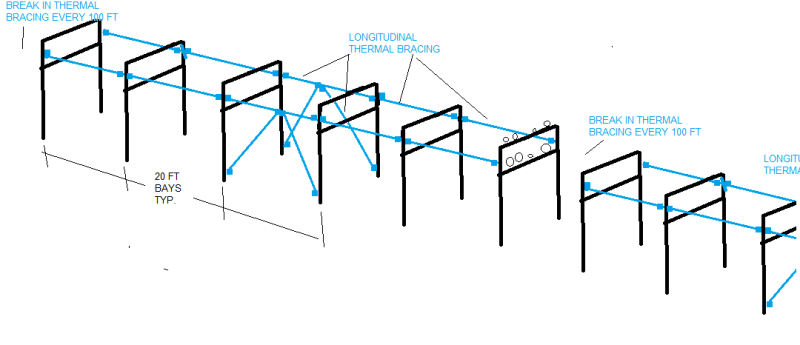So then thermal loads of bridges are ignored when the wind blows or the earth quakes?
DaRooster, This is because generally any good pipe stress design that you would be working with would be placing telfon slide plates, expansion joints, rollers, hangers, or something to allow this expansion without major friction.
Uh... Absolutely NOT! Teflon, rollers, or somethings are not normally used. The best it normally gets is steel pipe shoe sliding on a steel or concrete beam. Special circumstances ONLY. Structural expansion joints are not used in pipe rack design. Independent rack sections separated every 100 ft distribute the growth and contraction to amounts manageable without expansion joints in the structural steel frame. Much more important to consider that when designing long continuous conveyor belt bridges and towers.
TLHS, PIP STC01015 (like all codes and design specs) should be used only as a guide when specific and detailed knowledge and information about concurent loading conditions (or whatever else concerns you) is nonexistant.
SlideRuleEra,
wadavis,
Illbay, (I tend to agree with you, except for shut down load case)
Pipe supports or structures buffeted by wind, or otherwise shifting under the pipe is immaterial. The (maximum) value of any lateral load that can ever be transferred between a pipe simply resting (not welded anchored or guided) on its support is the weight of pipe and contents x friction factor. Thermal loads of the pipe to a support can increase only until [&fi;]W is reached, then slipping occurs so the load never reaches higher values. Likewise wind acting on pipe, transferring the load to supports below could also not reach values above [&fi;]W, otherwise the pipe would first move and perhaps even slip off the support. Likewise, wind should also be applied with thermal friction load during shutdown. Once the pipe has shifted on it's support "from wind buffeting" or whatever, to the thermal position, the thermal friction load might be less, however shutdown at that point would simply reverse the thermal friction load as the pipe cooled off to ambient temperature.
Rabbit12 (IMO you are using solid and good logic),
It is obvious to me that such concurrent wind (or seismic) and thermal loading (mentioned in the previous paragraph) can and will occur simultaneously. I think some percentage,50% Thermal loads are "dead" loads, as desing temps are used for design values and thermal effects are relatively well known, easily calculated and their application straight forward. Wind loads are live. Chose appropriate factors when applicable to your material design. In your T support case the 10% W[&fi;] would not apply, because the one or limited number of pipes would not counteract each other. Use 100% W[&fi;] for your small limited number of pipes.
Find what you like to do, earn a living at it, and then make your lifestyle fit your income. — Chuck Yeager

![[idea] [idea] [idea]](/data/assets/smilies/idea.gif)
![[r2d2] [r2d2] [r2d2]](/data/assets/smilies/r2d2.gif)
